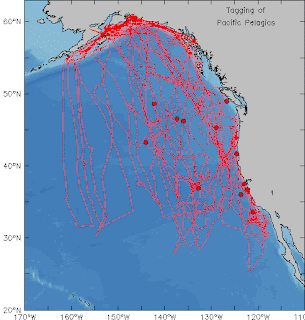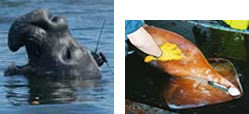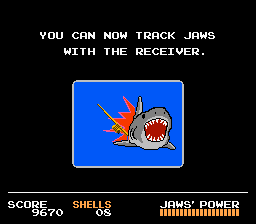Ever wonder where sea creatures have been or where they're headed? Thanks to marvelous modern technology and an ambitious team of prestigious scientific organizations, now you can watch in almost real-time! Since 2002, Tagging of Pacific Pelagic (TOPPS) research project has tagged over 2,000 animals with tiny microprocessors and sophisticated remote sensing systems to track exactly where, when and how deep they're traveling through the ocean.

Movements of twelve tagged salmon sharks over the last 60 days.
The results are fantastic maps showing up-to-the-minute movements of mako sharks, salmon sharks, elephant seals, southern elephant seals, California sea lions, blue whales, fin whales, leatherback sea turtles, loggerhead turtles, Humbolt squid and Laysan albotrosses among others. TOPPS is run by Stanford,Aeos Hopkins Marine Lab, the University of California, Santa Cruz,Aeos Long Marine Laboratory, NOAA,Aeos Pacific Fisheries Ecosystems Lab, and the Monterey Bay Aquarium.

Tagged elephant seal and tagged Humbolt squid.

Shark tagging was perfected in the late '80s.
Click here to see a step-by-step log of a tagging process from start to finish.





a blog site and have made a nice drop I follow the issues very, very good admin friend, your site always wish you greater success, more heart and soul I want to get to the masses